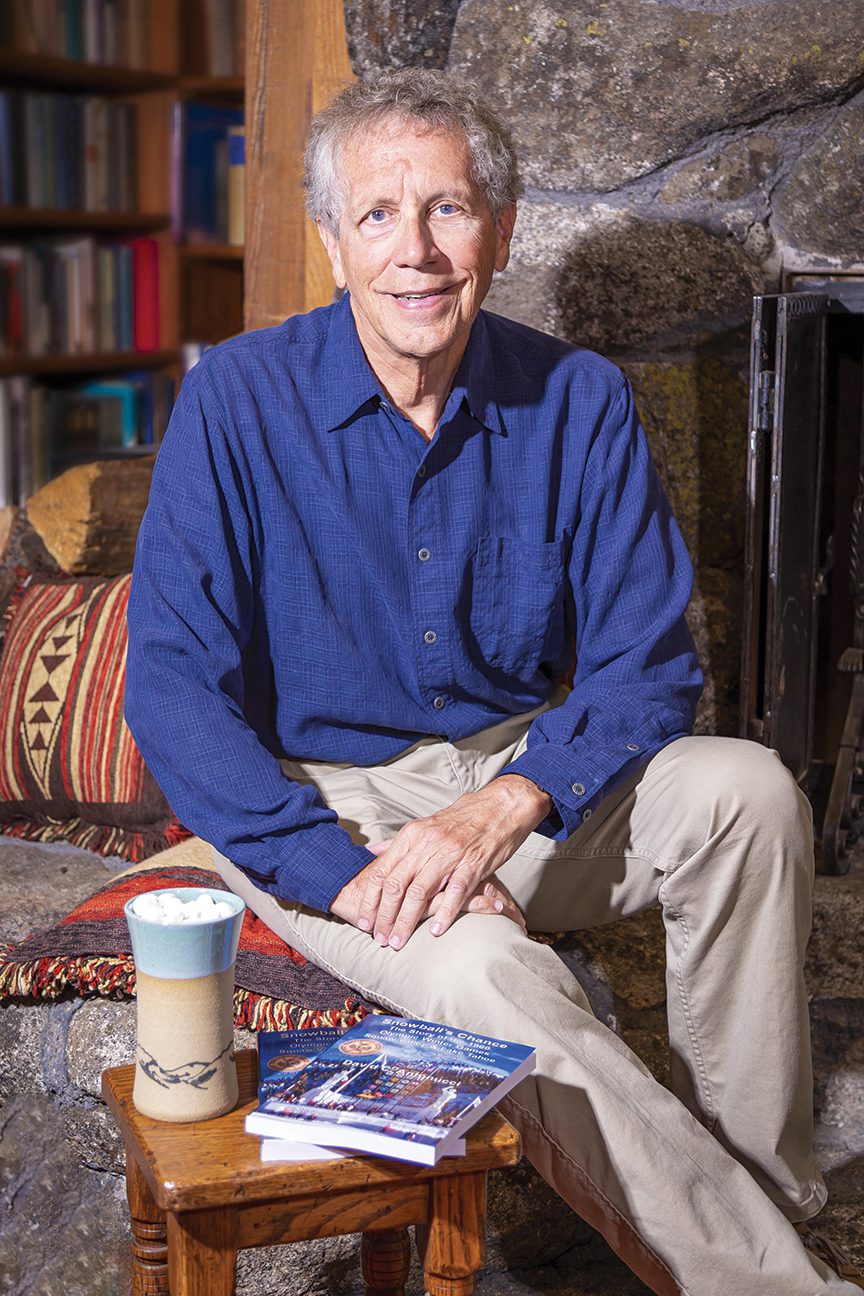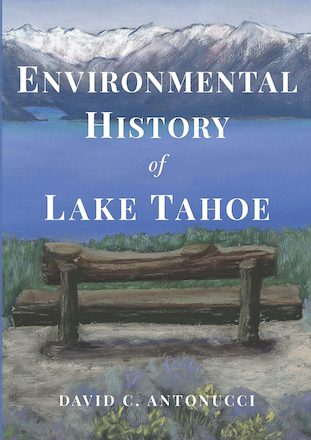
26 Nov A Master Tahoe Historian Pens His Most Ambitious Effort Yet
Longtime local resident and author David Antonucci publishes his third book: Environmental History of Lake Tahoe
There are those who dabble in Tahoe history, and then there is David Antonucci, whose vast knowledge of the region’s storied past could only be accumulated through decades of ardent research and experience.
“I can’t control myself,” Antonucci says of his propensity to dig deeply into Tahoe’s history, which has resulted in three books to date, with two more in the works. “It starts out as a chapter, and it becomes a book.”
 Since moving to Tahoe in the mid-1970s, Antonucci, creator of the popular TahoeFacts.com website, has played an important role in public policy as a civil and environmental engineer. And as an accomplished author, he continues to work tirelessly to portray the region’s rich—and at times checkered—past in a historically accurate manner.
Since moving to Tahoe in the mid-1970s, Antonucci, creator of the popular TahoeFacts.com website, has played an important role in public policy as a civil and environmental engineer. And as an accomplished author, he continues to work tirelessly to portray the region’s rich—and at times checkered—past in a historically accurate manner.
Antonucci’s commitment to veracity combined with his love of writing helped him publish his first two books in 2009 and 2011, Snowball’s Chance: The Story of the 1960 Olympic Winter Games, followed by Fairest Picture—Mark Twain at Lake Tahoe.
More than a decade after authoring the critically acclaimed books, the Tahoe historian released his most ambitious and in-depth effort yet, Environmental History of Lake Tahoe, which explores the evolution of environmental change at Tahoe as seen through the eyes of those who caused it, as well as those who sought to prevent it.
“I wanted to explain how we got to where we are today,” says Antonucci, 73. “Why Lake Tahoe looks the way it looks, explain why it was not a national park and explain how the Washoe Tribe were stewards and how that changed with the arrival of the Euro-Americans.”
First-Hand Knowledge
Antonucci certainly has the experience to tell the story.
Fresh out of college, and with degrees in civil and environmental engineering from Cal Poly and Oregon State University, the Southern California native arrived in the Tahoe Basin at age 24 to work as an engineer for the Lahontan Regional Water Quality Control Board, where he stayed from 1975-80.
“My job was to oversee the enforcement of new water pollution laws at Lake Tahoe and other northeastern California watersheds,” says Antonucci, who recalls after learning more about Tahoe’s political climate and environmental history: “The central pragmatic question that struck me was, ‘How did it get to this point, and why?’”
Antonucci, a Tahoma resident of nearly 50 years, left the Lahontan board in 1980 for the Tahoe City Public Utility District, where he worked for the next two decades as an engineer and later general manager.
After retiring from government, he continued working as an engineer and consultant for myriad private companies and public agencies while freeing up time for one of his chief passions: writing. This ultimately allowed him to begin answering the question he asked a half-century ago.
“I have always enjoyed writing,” says Antonucci. “In high school, I was a stringer for the local newspapers, and as I say, I wrote my way to success thereafter. Engineers are notorious for being poor writers and grammarians, so I stood out!”
A Deep Dive Into Tahoe’s Past
Published by Arcadia in August 2022, Antonucci’s latest book is based on both historical research and knowledge from working actively in Tahoe’s public sector.
Environmental History of Lake Tahoe begins with the Washoe Tribe occupying the region primarily in the summer for some 10,000 years, until 1848. Antonucci then moves to the discovery of Lake Tahoe by Euro-Americans traveling westward in the mid 1840s, and soon after to the dramatic impact of the California Gold Rush. Later, around the time of the Civil War, a 35-year period of extensive resource exploitation began, including logging in the Tahoe Basin to support the Comstock Lode silver mines in nearby Virginia City.
With the petering out of the silver mining boom, and the dearth of available forests to cut, between 1890 and 1930 the Tahoe region settled into a more quiet, seasonal tourism economy, with people arriving by train and then motoring around the lake via steamboat. Next came the rise of automobile tourism, which boosted the number of visitors and extended roads around the lake.
Coinciding with the 1960 Winter Olympics, Tahoe began a major tourism boom and shift to a year-round destination. As early as the 1970s, around the time a young Antonucci arrived at Tahoe, a movement began to control the rapid development around the lake, resulting in heated conflicts and the creation of the federally backed Tahoe Regional Planning Agency (TRPA), along with other public and private groups attempting to create a more sustainable economy and environment.
At 128 pages, with 74 photos, maps and illustrations spread throughout, Environmental History is an excellent read for anyone who wants to learn more about the history of Tahoe and the impact of humans on the environment.
As Antonucci puts it: “The story of Lake Tahoe is the story of people and the environment and their reciprocal influences.”
Spreading the Word
In addition to writing, Antonucci presents his books at public speaking engagements such as conferences and historical societies, including a recent discussion with a group of Mark Twain scholars in New York. His goal is to get more people interested in Tahoe.
“You do not do it for the money,” says Antonucci. “I do whatever I can to get [the books] out there. I want people to read and learn about Tahoe.”
True to Antonucci’s dedication to the pen, Environmental History is only the latest chapter in his writing endeavors. He recently completed a book about the geology of the Lake Tahoe Basin, which is set to publish in late 2023 or early 2024, and is working on a larger all-encompassing project about the history of the region’s flora and fauna.
Fellow Tahoe-based writer Eddy Ancinas can vouch for Antonucci’s prowess with historical prose. Ancinas, who wrote Squaw Valley and Alpine Meadows: Tales from Two Valleys in 2013, has worked with Antonucci over the past several years planning the SNOW Sports Museum, which will serve as a community hub memorializing the 1960 Winter Olympics and centuries of winter sports heritage in the Sierra Nevada.
Antonucci’s Snowballs Chance has been an important resource for the Olympic Valley museum and the creation of the nonprofit SNOW Sports Museum Foundation, says Ancinas.
“(David’s) engineering mind has been critical to keeping all the details straight on the museum,” she says. “His background working with public agencies, as well, has been really helpful to us. He is a wonderful person who has worked really hard.”
Hard work truly is a hallmark of Antonucci’s nearly 50-year career at Lake Tahoe. And while his books have covered a wide range of topics, they were all written with the same goal: to pass on useful information about his beloved home, so that people will not only fall in love with Tahoe, but protect it for generations to come.
Tim Hauserman, like David Antonucci, is a longtime local who has written several books focused on the beauty of Lake Tahoe. He wrote the official guide to the Tahoe Rim Trail, now on its fourth edition, along with his latest, Going it Alone: Ramblings and Reflections from the Trail, a memoir about finding joy, loneliness and laughter while hiking solo.




No Comments